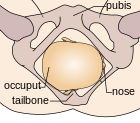Skull position
In the skull position or head position , the child lies lengthways in the womb, that is, lengthways along the vertical axis of the mother, and with the head down. Further options for childlike orientation are the breech position and the lateral position .
In the cephalic presentation, these are the real , that is the most common, normal location in the birth of the child (96%).
Position
In addition to the child's position , which describes the relationship between the child's longitudinal axis and the mother's longitudinal axis ( longitudinal position , transverse position , inclined position ), there is also the child's position. In practice, this describes the position of the child's back. A distinction is made between the 1st and the 2nd position (often abbreviated with the Roman numerals I and II), the numerals denoting the position of the back. I. means the back is on the left, II. Means the back is on the right.
The lateral position is used to assess the position of the child's head. If it is on the left side, it is an I. bank position; if it is on the right side, it is a II. Bank position.
A selection of possible posture anomalies. In the unproblematic birth, the child's head changes to a bent position until it reaches the pelvic outlet. However, if the bent posture is more or less absent or the head even assumes an extended posture (reclination), the following options are available:
- Vertex position,
- Fore-head position,
- Forehead position,
- Face position. These anomalies are rare.
Attitude (habitus)
This describes the longitudinal axis of the child's head in relation to the longitudinal axis of the child's trunk. An anterior occipital position is found in 92–93% of the cases of full term pregnancies . The posterior occipital position occurs in 3.5%, the deflection positions (anterior head, forehead and face positions) in 1% of cases.
attitude
If the attitude of the child's head to the birth canal is not correct , one speaks of an attitude anomaly .
literature
- Henning Schneider , Peter-Wolf Husslein : Obstetrics. 2nd Edition. Springer Verlag, Heidelberg et al. 2004, ISBN 3-540-44032-1 .
- Klaus Diedrich: Gynecology and Obstetrics. 2., completely reworked. Edition. Springer Verlag, Heidelberg 2007, ISBN 978-3-540-32867-4 .
Individual evidence
- ↑ Alexander Strauss, Walter Jonat, Klaus Diedrich (eds.): Treatment paths in gynecology and obstetrics. Springer, Berlin / Heidelberg 2013, ISBN 978-3-642-21300-7 , p. 123 f.
- ^ Gerhard Martius: Textbook of obstetrics, including obstetric operations. Georg Thieme, Stuttgart / New York 1985, ISBN 3-13-375311-8 , p. 322.








